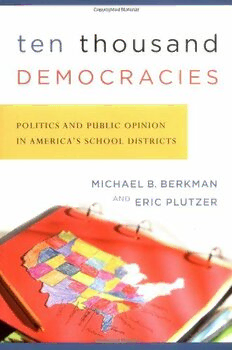
Ten Thousand Democracies (American Governance and Public Policy) PDF
227 Pages·2005·1.557 MB·English
Most books are stored in the elastic cloud where traffic is expensive. For this reason, we have a limit on daily download.
Preview Ten Thousand Democracies (American Governance and Public Policy)
Description:
This book provides the most extensive examination of democratic control of American public schools. Beginning with a look at educational reforms from the Progressive era in the late 19th and early 20th centuries through the civil rights movement and ending with Pennsylvania's 2004 tax relief measure, Berkman and Plutzer explore what factors determine education spending levels in school districts, including the effects of public opinion, the nature of local political institutions, and the roles played by special interests. The authors show how board members are selected, how well the boards represent minorities, whether the public can bypass the board through referenda, and how the schools are financed. By providing an innovative statistical portrait of the nations' 10,000 school districts, they answer questions central to democtratic control of our schools: how responsive are school boards to their public and when? How powerful are such special interests such as teachers' unions and senior citizens? Among their findings are the correlation of race, age, and home owner status with support for increased funding, that African Americans are more supportive than other races of educational spending, and that senior citizens with longstanding ties to their communities support school budgets. Their statistical method combining public opinion data with Census data is important and innovative, but the hard-core statistics are presented in appendices to make the text accessible to a wider audience.
See more
The list of books you might like
Most books are stored in the elastic cloud where traffic is expensive. For this reason, we have a limit on daily download.
